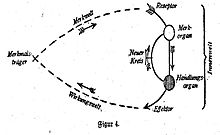
Back Món perceptiu Catalan Umwelt German Omailm ET Umwelt French Umwelt Italian 環世界 Japanese 움벨트 Korean Milieu Dutch Umwelt Portuguese Умвельт Russian
This article may be too technical for most readers to understand. (October 2024) |



An umwelt (plural: umwelten; from the German Umwelt meaning "environment" or "surroundings") is the specific way organisms of a particular species experience the world, which is dependant on what their sensory organs and perceptual systems can detect and interpret.[1]
In the semiotic theories of Jakob von Uexküll and Thomas Sebeok, it is considered to be the "biological foundations that lie at the very center of the study of both communication and signification in the human [and non-human] animal".[2][failed verification] The term is usually translated as "self-centered world".[3] Uexküll theorised that organisms can have different umwelten, even though they share the same environment. The term umwelt, together with companion terms Umgebung (an Umwelt as seen by another observer) and Innenwelt (the mapping of the self to the world of objects),[4] have special relevance for cognitive philosophers, roboticists and cyberneticians because they offer a potential solution to the conundrum of the infinite regress of the Cartesian Theater.[not verified in body]
- ^ Ha, James C.; Campion, Tracy L. (2019). "Chapter 2 - Why tails wag: Umwelts, innenwelts, and canine "guilt"". Dog Behavior. Academic Press. pp. 33–61. doi:10.1016/b978-0-12-816498-3.00002-x. ISBN 978-0-12-816498-3. Retrieved 2024-10-06.
- ^ Sebeok, Thomas A. (1976). "Foreword". Contributions to the Doctrine of Signs. Lisse, Netherlands: Peter de Ridder Press. p. x. ISBN 0-87750-194-7.
- ^ Kull, Kalevi (2010). "Umwelt". In Cobley, Paul (ed.). The Routledge Companion to Semiotics. London: Routledge. pp. 348–349. ISBN 978-0-415-44072-1.
- ^ Cobley, Paul (2010). The Routledge Companion to Semiotics. London and New York: Routledge. p. 348.